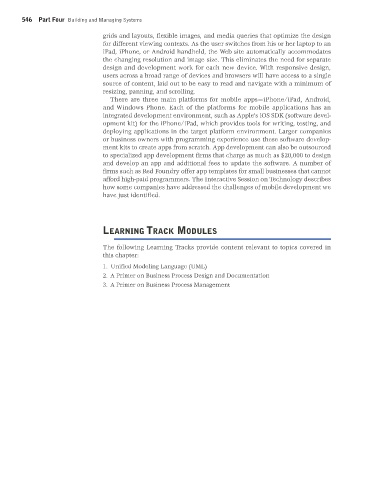Page 547 -
P. 547
546 Part Four Building and Managing Systems
grids and layouts, flexible images, and media queries that optimize the design
for different viewing contexts. As the user switches from his or her laptop to an
iPad, iPhone, or Android handheld, the Web site automatically accommodates
the changing resolution and image size. This eliminates the need for separate
design and development work for each new device. With responsive design,
users across a broad range of devices and browsers will have access to a single
source of content, laid out to be easy to read and navigate with a minimum of
resizing, panning, and scrolling.
There are three main platforms for mobile apps—iPhone/iPad, Android,
and Windows Phone. Each of the platforms for mobile applications has an
integrated development environment, such as Apple’s iOS SDK (software devel-
opment kit) for the iPhone/iPad, which provides tools for writing, testing, and
deploying applications in the target platform environment. Larger companies
or business owners with programming experience use these software develop-
ment kits to create apps from scratch. App development can also be outsourced
to specialized app development firms that charge as much as $20,000 to design
and develop an app and additional fees to update the software. A number of
firms such as Red Foundry offer app templates for small businesses that cannot
afford high-paid programmers. The Interactive Session on Technology describes
how some companies have addressed the challenges of mobile development we
have just identified.
LEARNING TRACK MODULES
The following Learning Tracks provide content relevant to topics covered in
this chapter:
1. Unified Modeling Language (UML)
2. A Primer on Business Process Design and Documentation
3. A Primer on Business Process Management
MIS_13_Ch_13 global.indd 546 1/17/2013 2:31:25 PM

